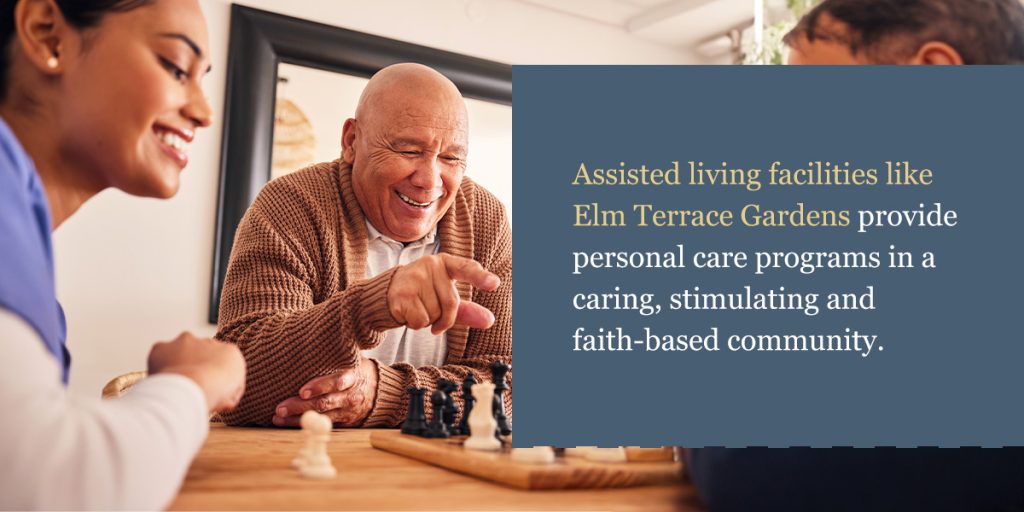
If you’re in the process of researching assisted living for yourself, your spouse or a loved one, it can quickly become overwhelming. After all, not everything you read about assisted living is true. For instance, assisted living does not mean you lose your independence.
Continuing care retirement communities have evolved to offer all levels of care for older adults to provide them with the support they need. As experts in assisted living, we’re here to explain how it works and answer your questions regarding what you should know about assisted living.
Contents:
Senior assisted living refers to residential communities where older adults — typically aged 55 and older — can live as independently as possible while having access to necessary support. As some adults age, they may find they are no longer able to manage living on their own as they develop different needs. These communities are ideal for 55+ adults who wish to remain in a comfortable, home-like setting and receive assistance with personal care or activities of daily living (ADL), including:
Assisted living is a long-term care option for many individuals who, while they may need additional support, do not require around-the-clock nursing care services. Many older adults prefer to spend their retirement years in assisted living communities to access a social, communal setting that eliminates the burden of homeownership and maintenance. In this type of residential care model, residents receive a personal care level unique to their needs, which might also include medication management and transportation.
So, how does assisted living differ from independent living? Though both types of residential communities are designed to offer convenience and support for older adults, independent living offers minimal assistance. Independent living is often more suitable for older adults who can complete their daily tasks and chores without the help of care staff.
Assisted living, alternatively, promotes an engaging and meaningful lifestyle while offering additional personal care services for those with mobility needs or cognitive limitations. Residents receive an enhanced quality of life with the flexibility to keep their autonomy.
An assisted living facility is a housing facility for older adults who are unable to or choose not to live independently. These facilities offer full-time living arrangements for eligible people with minimal restrictions to promote a home-like setting. Despite the term “facility,” these care settings are much more aligned with residential communities that provide the usual comforts of home.
Assisted living facilities vary in size, layout and level of care. Generally, these facilities range from a few dozen residents to over one hundred residents. Residents may have private living quarters or share with another person depending on preferences, availability and lifestyle needs.
Assisted living facilities are sometimes referred to as residential care facilities, long-term care facilities, adult care homes or residential care homes. It’s important to note that an assisted living facility is not the same thing as a nursing home — though these terms are often used interchangeably. A nursing home generally focuses on caring for residents who require more extensive medical, health and personal care. For example, older adults who require 24-hour nursing services may not be a good fit for an assisted living facility.

Amenities and services at assisted living facilities vary by location but prioritize the physical, mental and emotional well-being of all residents. Assisted living facilities like Elm Terrace provide personal care programs in a caring, stimulating and faith-based community. At Elm Terrace, residents receive a combination of assisted living and personal care services that support a self-directed, independent lifestyle. Here’s what’s often included with assisted living:
It can help to visualize an assisted living facility as a step above a retirement home but not as involved as a nursing home or hospital setting. As we mentioned above, assisted living is ideal for somebody who needs help or support performing activities of daily living, such as walking or taking medication.
If you or your loved one is unable to continue living independently due to difficulties in these daily tasks, a senior assisted living facility can help you remain independent and socially engaged as you age. Other individuals who may be suited to an assisted living community include those who:
Assisted living is perfect for older individuals who need extra day-to-day support while wanting to maintain their independence. There are many benefits of assisted living facilities, such as personalized care, socialization, a sense of community, and more.
It is a great fit for those who would benefit from assistance with daily tasks but prefer more independence. Assisted living provides a greater level of comfort and safety, while allowing individuals to enjoy their preferred lifestyle. If you thrive from socialization and meeting similar people, assisted living communities may be a good fit.

If you think you might be ready to take the next step in your retirement life, consider joining the Lifeplan community at Elm Terrace in Lansdale, Pennsylvania. Our quality personal care program offers older adults an independent lifestyle similar to assisted living. We give our residents the power to create a self-directed lifestyle with customizable financial, healthcare and lifestyle services.
Call us today or contact us online to learn more about our highly-rated assisted living community. We also encourage you to schedule your free lunch and tour for residents and their families so you can experience the Elm Terrace community for yourself!